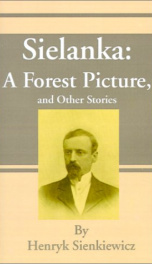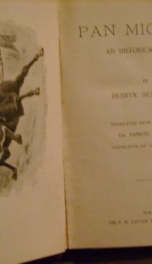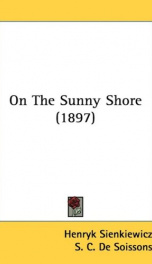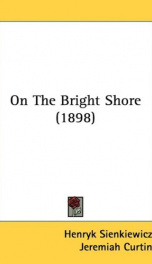Sienkiewicz Henryk

Henryk Adam Aleksander Pius Sienkiewicz (Polish pronunciation: [ˈxɛnrɨk ˈadam alɛˈksandɛr ˈpʲus ɕɛnˈkʲevʲitʂ]; also known as "Litwos" [ˈlitfɔs]; May 5, 1846–November 15, 1916) was a Polish journalist and Nobel Prize-winning novelist. He was one of the most popular Polish writers at the turn of the 19th and 20th centuries, and received the Nobel Prize in Literature in 1905 for his "outstanding merits as an epic writer." Born into an impoverished gentry family in the Podlasie village of Wola Okrzejska, in Russian-ruled Poland, Sienkiewicz wrote historical novels set during the Rzeczpospolita (Polish Republic, or Commonwealth). His works were noted for their negative portrayal of the Teutonic Order in The Teutonic Knights (Krzyżacy), which was remarkable as a significant portion of his readership lived under German rule. Many of his novels were first serialized in newspapers, and even today are still in print. In Poland, he is best known for his historical novels "With Fire and Sword", "The Deluge", and "Fire in the Steppe" (The Trilogy) set during the 17th-century Polish-Lithuanian Commonwealth, while internationally he is best known for Quo Vadis, set in Nero's Rome. Quo Vadis has been filmed several times, most notably the 1951 version. Sienkiewicz was meticulous in attempting to recreate the authenticity of historical language. In his Trilogy, for instance, he had his characters use the Polish language as he imagined it was spoken in the seventeenth century (in reality it was far more similar to 19th-century Polish than he imagined). In The Teutonic Knights, which relates to the Battle of Grunwald in 1410, he even had his characters speak a variety of medieval Polish which he recreated in part from archaic expressions then still common among the highlanders of Podhale. In 1881, Sienkiewicz married Maria Szetkiewicz (1854-1885). They had two children, Henryk Józef (1882-1959) and Jadwiga (1883-1969). Sienkiewicz was born in Wola Okrzejska, a village in eastern Poland's Podlasie region, that was part of the Russian Empire at the time. His was an impoverished gentry family, on his father's side deriving from Tartars who had settled in Lithuania. His family used the coat of arms Oszyk. His parents were Józef Sienkiewicz (1813–1896) and Stefania (née Cieciszowska), 1820-1873). Wola Okrzejska belonged to the writer's maternal grandmother, Felicjana Cieciszowska. He was baptized in the neighbouring village of Okrzeja in a church founded by his great-grandmother. His family moved several times and in the end settled in Warsaw in 1861. In 1858, Henryk began secondary school in Warsaw. He did not receive very good grades, but he was good at liberal arts. Because of the hard financial times nineteen-year-old Sienkiewicz took up a job as a tutor in the Weyher family in Płońsk. During that time he probably wrote his first novel, Ofiara (Victim). He also worked on his publicized novel Na marne (In Vain). He also finished his extramural classes in secondary school and in 1866 received the secondary school diploma. According to his parents' will, he passed the examination to the medical department at Warsaw University. After some time, he resigned and took up law studies. He ended up transferring to the Institute of Philology and History. He gained there thorough knowledge of literature and Old Polish. In 1867 he made his first attempts in literature and wrote a rhyming piece Sielanka Młodości, which he submitted for publication in Tygodnik Ilustrowany (Illustrated Weekly) but rejected. In 1869 Sienkiewicz debuted as a journalist. Przegląd Tygodniowy (The Weekly Review) printed his review of the play, and Tygodnik Ilustrowany printed his essay about Mikołaj Sęp-Sarzyński. Sienkiewicz wrote to Gazeta Polska (The Polish Gazette) and Niwa under the pen name "Litwos". In 1873 he started to write a column "Bez tytułu" ("Without a Title") in Gazeta Polska and in 1875 the series called "Chwila obecna" ("The Present Moment"). From 1874 he took care of literary department in Niwa. He wrote the novel Na marne (In Vain, 1871) and then Humoreski z teki Woroszyłły, Stary Sługa (The Old Servant, 1875), Hania (1876) and Selim Mirza (1877). The last three works are referred to as the Little Trilogy. Sienkiewicz also visited his relative Jadwiga Łuszczewska (known as "Deotyma") and the actress Helena Modrzejewska, as their dinner parties were very popular. In 1876 he went to the United States with Helena Modrzejewska. He stayed for some time in California. During that period he wrote Listy z podróży (Letters From a Journey), which were published in Gazeta Polska and received wide recognition. He also wrote Szkice węglem (Sketches in Charcoal) in 1877. The trip to the USA inspired him to write following works: Komedia z pomyłek (A Comedy of Errors, 1878), Przez stepy (1879), W krainie złota (1880), Za chlebem (For Bread, 1880), Latarnik (Lighthouse Keeper, 1881) Wspomnienia z Maripozy (1882), Sachem (1883). In 1878 Henryk Sienkiewicz went back to Europe. First he stayed in London and then went to Paris for a year. In France he had got a chance to familiarize himself with naturalism, a new trend in literature. In the article "Z Paryża" ("From Paris"), written in 1879, he expressed a positive opinion on this trend. He stated that, "For a novel naturalism was in fact a brilliant, indispensable and perhaps the only step forward." Two years later he changed his mind and became more critical about this trend. He expressed his opinions on naturalism and writing in general in following published works: O naturaliźmie w powieści (Naturalism in the Novel, 1881), O powieści historycznej (Historical novel, 1889), Listy o Zoli (Letters about Zola, 1893). His stay in America and his letter-writing published in Polish newspapers resulted in nationwide recognition and aroused interest. Bolesław Prus in his article entitled "Co p. Sienkiewicz wyrabia z piękniejszą połową Warszawy", published in Kurier Warszawski in 1880, nicely showed the popularity of the writer. "As he was back from America, almost every lady took tall and handsome men for Sienkiewicz.(...) Finally, when I noticed that every man has got hair like Sienkiewicz and all of the young men, one by one, grow royal beard and try to have statuesque and swarthy face, I realised that I wanted to meet him personally.(...) From the corner where I sit, I can see that the room is almost exclusively crowded with the fair sex. Some men, who were there to amuse ladies or to write reports, spent so much time in the company of women that they started to talk in the feminine. In 1879 in Lviv, Sienkiewicz gave a lecture entitled Z Nowego Jorku do Kalifornii. In 1880 at Bazar hotel in Poznań he read his novel Za chlebem, and later in Warsaw he read two works on naturalism in literature. In Szczawnica, on his way back to Lviv in 1879, he read a work about his stay in America. That was also the place where he saw his future wife, Maria Szetkiewicz, for the first time. As he discovered that the whole Szetkiewicz family was going to Venice, Sienkiewicz went there too and met Maria personally. They got married on 18 August 1881, on Theatre Square in a church which was a property of the Community of Canonesses (the church no longer exists). They had two children, Henryk Józef and Jadwiga Maria. The marriage did not last long because Maria died on 18 August 1885. In 1882 he worked with Słowo (a daily newspaper with a tendency to conservatism and nobility). In the beginning, he was the editor-in-chief. He wrote a drama Na jedną kartę which was later staged in Lviv and Warsaw (1879-1881) In 1880 Sienkiewicz wrote a historical novella, Niewola tatarska (Tartar Captivity), and began work on a historical novel, Ogniem i Mieczem (With Fire and Sword). In a letter of February 1, 1884, to Stanisław Smolka, editor of the Kraków newspaper Czas, Sienkiewicz wrote: "With regard to the great novel, it will probably be titled Wilcze gniazdo (The Wolf's Nest). It takes place during the reign of King Jan Kazimierz, during the Cossack revolt." The novel Wilcze gniazdo appeared in installments in Słowo from May 2, 1883, to March 1, 1884, under the title Ogniem i mieczem (With Fire and Sword). Simultaneously it ran in the Kraków newspaper, Czas. With Fire and Sword was enthusiastically received by readers (as were the next two volumes of the Trilogy) and won the author national recognition. Many readers wrote Sienkiewicz, asking about the next adventures of their favorite characters. In 1879 a street in Zbarazh (one of the settings in With Fire and Sword) was named after Sienkiewicz; in 1900 its citizens would not permit building works on the church grounds, believing that it was the place where Pan Podbipięta (a fictional character in With Fire and Sword) was buried. The novel was also adapted for the stage. In 1884 Jacek Malczewski exhibited tableaux vivants inspired by With Fire and Sword. The novel garnered also some criticism. It was pointed out, not without reason, that some of the historical facts and events were misrepresented and distorted. He began writing the second volume of his Trilogy – Potop ("The Deluge"); according to Sienkiewicz the title was supposed to indicate the deluge of masses of people trying to stop the Swedish invasion. Potop was printed in Słowo (from 23 December 1884 to 2 September 1886). The novel quickly became a best-seller and it established Sienkiewicz's position in society. While Sienkiewicz was writing Potop, his wife, Maria Szetkiewicz, died of tuberculosis. It was a difficult time for the writer. After Maria's death Sienkiewicz went to Constantinople (through Bucharest and Varna) from where he was writing reports. After his return to Warsaw the third volume of the Trilogy, Pan Wołodyjowski (Fire in the Steppe) appeared. The novel was published in Słowo from May 1887 to May 1888. The Trilogy made Henryk Sienkiewicz the most widely read and known Polish novelist. Stefan Żeromski wrote in his Diaries: "In the Sandomierz area I witnessed myself that everybody, even those who usually do not read, were asking about The Deluge." Sienkiewicz was given 15 thousand roubles in recognition of his achievements from unknown fan who signed himself as Michał Wołodyjowski (the name of the character in the Trilogy). Sienkiewicz used this money to open the scholarship fund (named after his wife) designed for artists endangered by tuberculosis.
do you like this author?
What readers are saying
What do you think? Write your own comment on this book!
write a commentWhat readers are saying
What do you think? Write your own comment on this author!
write a commentBook list

On the Field of GloryAn Historical Novel of the Time of King John Sobieski
Series:
Unknown
Year:
Unknown
Raiting:
5/5
Show more
add to favoritesadd In favorites

Pan MichaelAn Historical Novel of Poland,the Ukraine,and Turkey.
Series:
Unknown
Year:
Unknown
Raiting:
4/5
Show more
add to favoritesadd In favorites
Book list

On the Field of GloryAn Historical Novel of the Time of King John Sobieski
Series:
Unknown
Year:
Unknown
Raiting:
5/5
Show more
add to favoritesadd In favorites

Pan MichaelAn Historical Novel of Poland,the Ukraine,and Turkey.
Series:
Unknown
Year:
Unknown
Raiting:
4/5
Show more
add to favoritesadd In favorites

The Deluge,Vol. II. (of 2)An Historical Novel of Poland,Sweden,and Russia.
Series:
Unknown
Year:
Unknown
Raiting:
4/5
Show more
add to favoritesadd In favorites

The Deluge,Vol. I. (of 2)An Historical Novel of Poland,Sweden,and Russia.
Series:
Unknown
Year:
Unknown
Raiting:
4.5/5
Show more
add to favoritesadd In favorites

With Fire and SwordAn Historical Novel of Poland and Russia.
Series:
Unknown
Year:
Unknown
Raiting:
3.5/5
Show more
add to favoritesadd In favorites

Quo Vadis (Πού πηγαίνεις)
Μυθιστόρημα της Νερωνικής Εποχής
Series:
Unknown
Year:
Unknown
Raiting:
3/5
Show more
add to favoritesadd In favorites

sielanka a forest picture and other stories
Series:
Unknown
Year:
Unknown
Raiting:
5/5
Contains seventeen Sienkiewicz stories: Sielanka, A Forest Picture For Bread Orso Whose Fault? The Decision of Zeus On a Single Card Yanko, the Musician Bartek, the Victor Across the Plains From the Diary of a Tutor in Poznan The Light-House Keeper of Aspinwall Yamyol, a Village Sketch The Bull-Fight, A Reminiscence of Spain Sachem A Comedy of Errors A Journey to Athens Zola ("Doctor Pascal")
Show more
add to favoritesadd In favorites

pan michael an historical novel of poland the ukraine and turkey a sequel to
Series:
Unknown
Year:
Unknown
Raiting:
4/5
"Pan Michael" rounds out the Trilogy that has bridged stylistic centuries and proven there is an ageless recipe for plot, drama, character and objective. . In Poland and Lithuania, where the edges of three great religions, and dozens of ethnic groups ebbed and flowed over the multicolored plains in endless kaleidoscopes of struggle, Sinkiewicz paints a vast landscape of dramatic and epic action. He does this without losing the artist's eye for color or the political opportunist's artful demonstration of back-room dealings and rationales used by the shakers and movers of the novel's time-period. Written by the novelist who won the Nobel Prize for Literature in 1905 for ‘Quo Vadis’, this work is highly recommended.
Show more
add to favoritesadd In favorites
Show more

pan michael an historical novel
Series:
Unknown
Year:
Unknown
Raiting:
5/5
Originally written in polish.
Show more
add to favoritesadd In favorites

on the sunny shore
Series:
Unknown
Year:
Unknown
Raiting:
4/5
This volume is produced from digital images created through the University of Michigan University Library's large-scale digitization efforts. The Library seeks to preserve the intellectual content of items in a manner that facilitates and promotes a variety of uses. The digital reformatting process results in an electronic version of the original text that can be both accessed online and used to create new print copies. The Library also understands and values the usefulness of print and makes reprints available to the public whenever possible. This book and hundreds of thousands of others can be found in the HathiTrust, an archive of the digitized collections of many great research libraries. For access to the University of Michigan Library's digital collections, please see http://www.lib.umich.edu and for information about the HathiTrust, please visit http://www.hathitrust.org --This text refers to the Paperback edition.
Show more
add to favoritesadd In favorites

on the field of glory an historical novel of the time of king john sobieski
Series:
Unknown
Year:
Unknown
Raiting:
4/5
Do not let pass this patriotically and beautifully written book of a Polish writer of the second half of the nineteenth century Henryk Sienkiewicz, the 1905 Nobel Prize winner. On the Field of Glory, his last published book, starts with dramatic events in the heart of Poland. The miraculous rescue, a love-story, absorbing plot, combination of truth and fiction add particular fascination to the novel. While reading it you will really get a sense of the times from Sienkiewicz. But the main thing is the patriotic feeling with which it was written, and which practically leaps off the page at you.
Show more
add to favoritesadd In favorites

on the bright shore
Series:
Unknown
Year:
Unknown
Raiting:
5/5
This volume is produced from digital images created through the University of Michigan University Library's large-scale digitization efforts. The Library seeks to preserve the intellectual content of items in a manner that facilitates and promotes a variety of uses. The digital reformatting process results in an electronic version of the original text that can be both accessed online and used to create new print copies. The Library also understands and values the usefulness of print and makes reprints available to the public whenever possible. This book and hundreds of thousands of others can be found in the HathiTrust, an archive of the digitized collections of many great research libraries. For access to the University of Michigan Library's digital collections, please see http://www.lib.umich.edu and for information about the HathiTrust, please visit http://www.hathitrust.org --This text refers to the Paperback edition.
Show more
add to favoritesadd In favorites

lillian morris and other stories
Series:
Unknown
Year:
Unknown
Raiting:
5/5
Contains the stories "Lillian Morris," "Sachem," "Yamyl," and "The Bull-Fight." Known for their great narrative power and contain vivid characterizations, Sienkiewicz' work includes the great trilogy of historical novels With Fire and Sword (1884), The Deluge (1886), and Pan Michael (1887-88). Henryk (Adam Alexander Pius) Sienkiewicz (1846-1916) was a Polish novelist. He studied at Warsaw, traveled in the United States, and in the 1870s began to write articles, short stories, and novels. His most widely known book is the story of Rome under Nero, Quo Vadis? (1896), several times filmed, notably in 1951 by Mervyn Le Roy (1900-87). He received the Nobel Prize for Literature in 1905. --This text refers to an alternate Paperback edition.
Show more
add to favoritesadd In favorites
What readers are saying
What do you think? Write your own comment on this author!
write a commentGenre
- Books / History / Americas
- Literature & Fiction / Literary
- Books / Children's Books / History & Historical Fiction
- Literature & Fiction / Contemporary
- Literature & Fiction / Classics
- Religion & Spirituality
- Religion & Spirituality / Christianity / Literature & Fiction / Fiction
- Nonfiction / Education / Education Theory / History
if you like Sienkiewicz Henryk try:
readers also enjoyed
What readers are saying
What do you think? Write your own comment on this author!
write a commentGenre
- Books / History / Americas
- Literature & Fiction / Literary
- Books / Children's Books / History & Historical Fiction
- Literature & Fiction / Contemporary
- Literature & Fiction / Classics
- Religion & Spirituality
- Religion & Spirituality / Christianity / Literature & Fiction / Fiction
- Nonfiction / Education / Education Theory / History
if you like Sienkiewicz Henryk try:
readers also enjoyed
Do you want to read a book that interests you? It’s EASY!
Create an account and send a request for reading to other users on the Webpage of the book!

